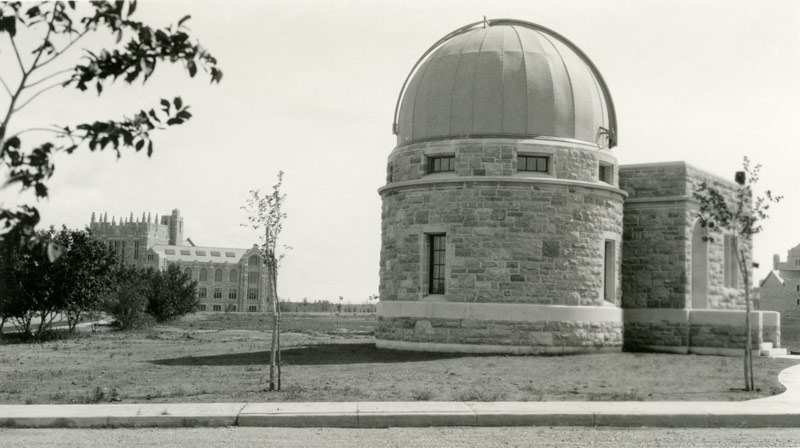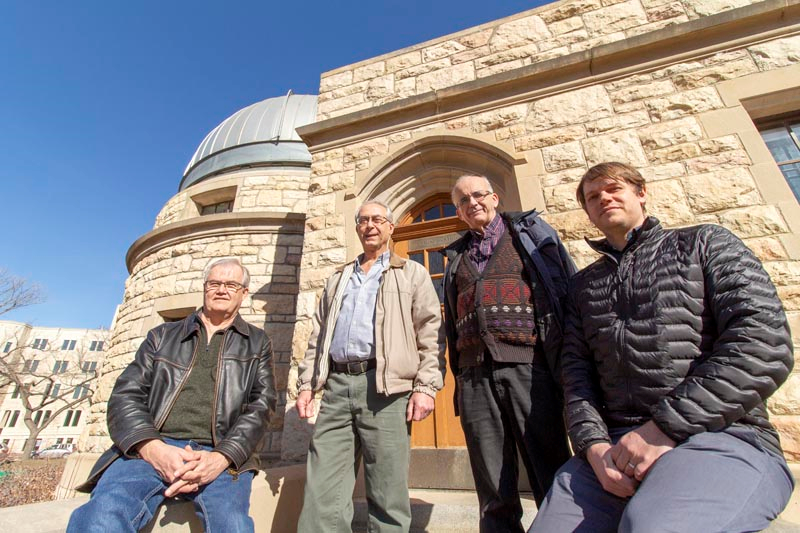
‘My heart’s in this building’: Reflecting on the campus observatory as it turns 90
One of the most iconic facilities on the University of Saskatchewan (USask) campus is celebrating its 90th birthday in April.
By Shannon BoklaschukThe Observatory, which opened in April 1929, houses a three-metre-long refracting telescope with a six-inch-diameter lens. During the past nine decades, thousands of students, researchers and members of the public have used that original telescope to view celestial objects in the sky, including planets, nebulae, star clusters, galaxies and even comets. The viewing of Halley’s Comet in 1986, for example, was a highly popular event, with hundreds of people lining up to a get a glimpse of the comet that can only be seen every 76 years.
“It’s really important for Saskatoon, for the university, to have The Observatory here,” said USask alumnus Daryl Janzen (BSc’04, MSc’08, PhD’12), a current staff member in the College of Arts and Science’s Department of Physics and Engineering Physics.
“People come who have never looked at the moon or any of the planets and are able to see Saturn or the moon for the first time. It’s very special to a lot of people, so it’s an important thing that we have in the city.”

Janzen is organizing a public event at USask to celebrate the 90th anniversary of the facility’s opening. The event will be held on April 15 in Physics 107 at 7:30 pm and will feature speakers discussing The Observatory’s history and the history of astronomy at USask.
The campus observatory was constructed in two phases between 1928 and 1930, at a cost of about $23,000. Private donations supplemented university funding, and a plaque with donor names still hangs inside the dome of the observatory. Saskatoon residents will find many of the names to be recognizable today.
“The building, or the equipment in the building, would not be possible without those donors—which means that there was appreciable community involvement in the development of this building and its equipment,” said Yannis Pahatouroglou, a recently retired staff member from the Department of Physics and Engineering Physics.
The Observatory was the third building to be built at USask, said Pahatouroglou. That shows developing it was a priority and that science—specifically astronomy—was important to the university, he noted.
“There is a rich history associated with the campus observatory,” said Pahatouroglou.
“Back then, it was associated with the Department of Mathematics. Around 1940, it switched over to physics—because astronomy became less of a mathematical science and more of a physical science, and so the physics department took it over.
“Since then, Gordon Patterson—who was my predecessor—was very active in the Royal Astronomical Society and he, in essence, established a big base of interest both for astronomy and the campus observatory. This is the past, and we are now trying to continue this legacy. Although this is an old building—the equipment we have is old—still there are a lot of things we can do with the telescope we have here. I think it’s quite an important addition to Saskatoon’s heritage that this building exists.”
Retired educator Ron Waldron (BEd’77, MEduc’02) worked at The Observatory from 1970 – 1985. He looks back on that time with fondness, describing the 15-year period as an important part of his life.
“My heart’s in this building in a lot of ways. This building helped to steer the direction of my life. In 1970 I was a young man starting out in a teaching profession, but I worked here in the evenings and even on Sunday afternoons, opening it up to the public,” he said.

“So my heart is really in this building, and one of the things I realized as I was working in the dead of winter—on a Wednesday night—is that people would be all around me, it would be freezing cold up in the dome, and I didn’t feel the cold at all. I felt the warmth of the people and what I was doing. I’m only saying that because it had that kind of impact on my life. I realized something about myself: that I’m either very comfortable, or at my best, when I’m explaining things to people—and my life has gone in that direction since then.”
Longtime astronomy lecturer Stan Shadick (BSc’76) recently retired from USask after working in the Department of Physics and Engineering Physics for nearly 40 years. Shadick recalls first visiting The Observatory as a young boy in the mid-1960s, when he attended a meeting of the Royal Astronomical Society with his father. The club, which was just starting up in Saskatoon at that time, met in The Observatory, cramming about 40 to 50 people into the building’s small classroom.

Over the years, Shadick’s interest in astronomy continued and grew. He eventually got a job in the physics department that involved managing the staffing of The Observatory and hiring students to run tours. However, because Shadick had completed a master’s degree before he was hired, his role in the department became increasingly focused on teaching astronomy. Utilizing the campus observatory’s facilities helped play a key role in building and enhancing USask’s astronomy program, he said.
“One of the strengths is we have a dome and we have this classroom, so it’s a perfect classroom for bringing university students for an observatory lab,” said Shadick.
“It’s also fantastic that, because it’s located so centrally in the city, we get a lot of tourists. It is, actually, one of the major tourist destinations within the city of Saskatoon—and it has been forever, since it’s been here.”
The Observatory, located one block north of the intersection of Wiggins Avenue and College Drive, attracts about 5,000 visitors per year. The facility is open to the public and staffed on Saturday nights, with the hours changing throughout the year. From April through August, viewing takes place on Saturdays from 9:15 pm – 11:45 pm.
-
Article was originally published on https://artsandscience.usask.ca/news/

